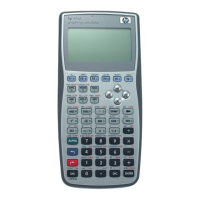Full Command and Function Reference 3-225
Input/Output:
Level 2/Argument 1 Level 1/Argument 2 Level 1/Item 1
obj
1
obj
2
→
0/1
(x,0) x
→
0/1
x (x,0)
→
0/1
z 'symb'
→
'z == symb'
'symb' z
→
'symb == z'
'symb
1
' 'symb
2
'
→
'symb
1
== symb
2
'
See also: SAME, TYPE, <, ≤, >, ≥, ≠
! (Store)
Type: Command
Description:
Store Command: Stores an object into a specified variable. To create a backup object, store the
obj into the desired backup location (identified as :n
port
:name
backup
). ! will not overwrite an existing
backup object. To replace an element of an array or list, use STO. Also use STO to store a
graphic object into PICT or a library or backup object into a port.
Access: K
Input/Output:
Level 2/Argument 1 Level 1/Argument 2 Level 1/Item 1
obj 'name'
→
obj
obj :n
port
:name
backup
→
obj
See also: DEFINE, RCL, →, STO
→ (Create Local)
Type: Command
Description: Create Local Variables Command: Creates local variables.
Local variable structures specify one or more local variables and a defining procedure.
A local variable structure consists of the
→ command, followed by one or more names, followed
by a defining procedure—either a program or an algebraic. The
→ command stores objects into
local variables with the specified names. The resultant local variables exist only while the defining
procedure is being executed. The syntax of a local variable structure is one of the following:
• → name
1
name
2
… name
n
« program »
• → name
1
name
2
… name
n
'algebraic expression'
Access: …é (é is the right-shift of the 0key).
Input/Output:
Leveln/Argument1 … Level1/Argumentn Level 1/Item 1
obj
1
… obj
n
→
See also: DEFINE, LOCAL, STO

